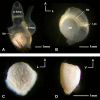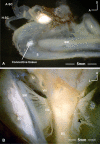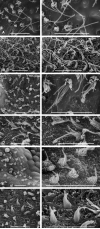The Inner Ear and its Coupling to the Swim Bladder in the Deep-Sea Fish Antimora rostrata (Teleostei: Moridae)
- PMID: 21532967
- PMCID: PMC3082141
- DOI: 10.1016/j.dsr.2010.11.001
The Inner Ear and its Coupling to the Swim Bladder in the Deep-Sea Fish Antimora rostrata (Teleostei: Moridae)
Abstract
The inner ear structure of Antimora rostrata and its coupling to the swim bladder were analyzed and compared with the inner ears of several shallow-water species that also have similar coupling. The inner ear of Antimora has a long saccular otolith and sensory epithelium as compared to many other fishes. Some parts of the membranous labyrinth are thick and rigid, while other parts are thinner but attached tightly to the bony capsule. The partially rigid membranous labyrinth, along with its intimate connection to the swim bladder, may help the inner ear follow the sound oscillations from the swim bladder with better precision than would occur in a less rigid inner ear. In addition, the saccular sensory epithelium has an elaborate structure and an anterior enlargement that may be correlated with increased hearing sensitivity. Some of the features in the inner ear of Antimora may reflect the functional specialization of deep-water living and support the hypothesis that there is enhanced inner ear sensitivity in some deep-sea fishes.
Figures








Similar articles
-
Are accessory hearing structures linked to inner ear morphology? Insights from 3D orientation patterns of ciliary bundles in three cichlid species.Front Zool. 2014 Mar 19;11(1):25. doi: 10.1186/1742-9994-11-25. Front Zool. 2014. PMID: 24645675 Free PMC article.
-
A unique swim bladder-inner ear connection in a teleost fish revealed by a combined high-resolution microtomographic and three-dimensional histological study.BMC Biol. 2013 Jul 4;11:75. doi: 10.1186/1741-7007-11-75. BMC Biol. 2013. PMID: 23826967 Free PMC article.
-
Parasites of the Blue Antimora, Antimora rostrata and Slender Codling, Halargyreus johnsonii (Gadiformes: Moridae), in the Northwestern Atlantic.Acta Parasitol. 2019 Sep;64(3):489-500. doi: 10.2478/s11686-019-00074-4. Epub 2019 Jun 11. Acta Parasitol. 2019. PMID: 31187388
-
Peripheral Hearing Structures in Fishes: Diversity and Sensitivity of Catfishes and Cichlids.Adv Exp Med Biol. 2016;877:321-40. doi: 10.1007/978-3-319-21059-9_15. Adv Exp Med Biol. 2016. PMID: 26515321 Review.
-
Diversity of Inner Ears in Fishes: Possible Contribution Towards Hearing Improvements and Evolutionary Considerations.Adv Exp Med Biol. 2016;877:341-91. doi: 10.1007/978-3-319-21059-9_16. Adv Exp Med Biol. 2016. PMID: 26515322 Review.
Cited by
-
Development of Bionic Semicircular Canals and the Sensation of Angular Acceleration.Bioengineering (Basel). 2022 Apr 20;9(5):180. doi: 10.3390/bioengineering9050180. Bioengineering (Basel). 2022. PMID: 35621458 Free PMC article.
-
Relationship between swim bladder morphology and hearing abilities--a case study on Asian and African cichlids.PLoS One. 2012;7(8):e42292. doi: 10.1371/journal.pone.0042292. Epub 2012 Aug 7. PLoS One. 2012. PMID: 22879934 Free PMC article.
-
Are accessory hearing structures linked to inner ear morphology? Insights from 3D orientation patterns of ciliary bundles in three cichlid species.Front Zool. 2014 Mar 19;11(1):25. doi: 10.1186/1742-9994-11-25. Front Zool. 2014. PMID: 24645675 Free PMC article.
-
Inner ear morphology in the Atlantic molly Poecilia mexicana--first detailed microanatomical study of the inner ear of a cyprinodontiform species.PLoS One. 2011;6(11):e27734. doi: 10.1371/journal.pone.0027734. Epub 2011 Nov 15. PLoS One. 2011. PMID: 22110746 Free PMC article.
-
Semicircular canal biomechanics in health and disease.J Neurophysiol. 2019 Mar 1;121(3):732-755. doi: 10.1152/jn.00708.2018. Epub 2018 Dec 19. J Neurophysiol. 2019. PMID: 30565972 Free PMC article. Review.
References
-
- Bailey DM, Bagley PM, Jamieson AJ, Collins MA, Priede IG. In situ investigation of burst swimming and muscle performance in the deep-sea fish Antimora rostrata. J. Exp. Mar. Biol. Ecol. 2003;286:295–311.
-
- Bierbaum G. Untersuchungen über den Bau der Gehörorgane von Tiefseefischen. Z. Wiss. Zool. 1914;III:281–380.
-
- Bregman AS. Auditory Scene Analysis: The Perceptual Organization of Sound. MIT Press; Cambridge, MA: 1990.
-
- Bregman AS, Peter Dallos, Donata Oertel. Auditory scene analysis. In: Basbaum AI, Kanenko A, Shepherd GM, Westheimer G, editors. The Senses: A Comprehensive Reference. Vol 3, Audition. Academic Press; San Diego: 2008. pp. 861–870.
-
- Buran BN, Deng X, Popper AN. Structural variation in the inner ears of four deep-sea Elopomorph fishes. J. Morph. 2005;265:215–225. - PubMed
Grants and funding
LinkOut - more resources
Full Text Sources
